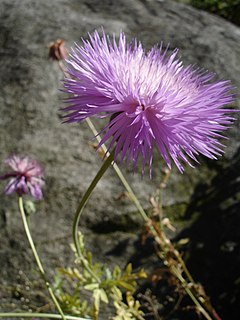
The Bromeliaceae are a family of monocot flowering plants of 51 genera and around 3475 known species native mainly to the tropical Americas, with a few species found in the American subtropics and one in tropical west Africa, Pitcairnia feliciana.

Augustin Pyramusde Candolle was a Swiss botanist. René Louiche Desfontaines launched de Candolle's botanical career by recommending him at an herbarium. Within a couple of years de Candolle had established a new genus, and he went on to document hundreds of plant families and create a new natural plant classification system. Although de Candolle's main focus was botany, he also contributed to related fields such as phytogeography, agronomy, paleontology, medical botany, and economic botany.

The Primulaceae, commonly known as the primrose family, are a family of herbaceous and woody flowering plants including some favorite garden plants and wildflowers. Most are perennial though some species, such as scarlet pimpernel, are annuals. It includes the former families Myrsinaceae, Theophrastaceae and Maesaceae.

Puya is a genus of the botanical family Bromeliaceae, subfamily Pitcairnioideae. These terrestrial plants are native to the Andes Mountains of South America and southern Central America. Many of the species are monocarpic, with the parent plant dying after one flower and seed production event.
The International Code of Nomenclature for Cultivated Plants (ICNCP), also known as the Cultivated Plant Code, is a guide to the rules and regulations for naming cultigens, plants whose origin or selection is primarily due to intentional human activity. Cultigens under the purview of the ICNCP include cultivars, Groups, and grexes. All organisms traditionally considered to be plants are included. Taxa that receive a name under the ICNCP will also be included within taxa named under the International Code of Nomenclature for algae, fungi, and plants, for example, a cultivar is a member of a species.

Vriesea is a genus of the botanical family Bromeliaceae, subfamily Tillandsioideae. The genus name is for Willem Hendrik de Vriese, Dutch botanist, physician (1806–1862). Its species are widespread over Mexico, Central America, South America and the West Indies.

Fosterella is a genus of plants in the family Bromeliaceae, subfamily Pitcairnioideae. It contains 31 recognized species, 30 native to central and western South America, one to Mesoamerica. The genus is named after Mulford B. Foster, American horticulturist and collector (1888-1978).

Billbergia is a genus of flowering plants in the family Bromeliaceae, subfamily Bromelioideae. The genus, named for the Swedish botanist, zoologist, and anatomist Gustaf Johan Billberg, is divided into two subgenera: Billbergia and Helicodea. They are native to forest and scrub, up to an altitude of 1,700 m (5,577 ft), in southern Mexico, the West Indies, Central America and South America, with many species endemic to Brazil.

Amberboa moschata is a Southwest Asian species of plants in the sunflower family. It is native to Turkey, Iraq, Iran, and the Caucasus. It is also widely cultivated in many places as an ornamental, and is reportedly naturalized in parts of China and North America.

Dyckia is a genus of plants in the family Bromeliaceae, subfamily Pitcairnioideae.

Glomeropitcarnia is a genus of the botanical family Bromeliaceae, subfamily Tillandsioideae. The genus name is from the Latin “glomero” and the genus Pitcairnia. It has two known species, native to Venezuela, Trinidad and the Lesser Antilles.

Hohenbergia is a genus of plants in the family Bromeliaceae, subfamily Bromelioideae. It is native to the West Indies, the Yucatán Peninsula, and northern South America.

Guzmania lingulata, the droophead tufted airplant or scarlet star, is a species of flowering plant in the family Bromeliaceae, subfamily Tillandsioideae, native to rainforest habitats in Central America, northern and central South America, southern Mexico and the West Indies. It is an evergreen epiphytic perennial. The Latin word lingulata means "tongue-shaped". Foliage grows in a star-shaped basal rosette which culminates in an orange and red bracted inflorescence. It is among the most commonly cultivated bromeliad types, with cultivars producing flowers in shades of maroon, red, orange, yellow or pink.

Rapanea is a genus of plant in family Primulaceae. It has often been placed in synonymy with Myrsine, and many species have been moved to Myrsine.
Megastachya is a genus of African plants in the grass family.

Guzmania monostachia is an epiphytic species in the genus Guzmania. Also known as a West Indian tufted airplant, this species is native to South America, Central America, the West Indies and Florida. The species is also reportedly naturalized in Hawaii.
Tillandsia festucoides, commonly known as the fescue airplant, is a species of bromeliad that is native to the Greater Antilles, Mexico, the Cayman Islands, and Central America.















